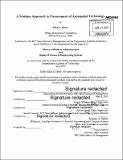| dc.contributor.advisor | Daniel Whitney and Steven Spear. | en_US |
| dc.contributor.author | Ebner, Ellen E. (Ellen Elizabeth) | en_US |
| dc.contributor.other | Leaders for Global Operations Program. | en_US |
| dc.date.accessioned | 2015-09-29T18:56:35Z | |
| dc.date.available | 2015-09-29T18:56:35Z | |
| dc.date.copyright | 2015 | en_US |
| dc.date.issued | 2015 | en_US |
| dc.identifier.uri | http://hdl.handle.net/1721.1/98980 | |
| dc.description | Thesis: M.B.A., Massachusetts Institute of Technology, Sloan School of Management, 2015. In conjunction with the Leaders for Global Operations Program at MIT. | en_US |
| dc.description | Thesis: S.M., Massachusetts Institute of Technology, Engineering Systems Division, 2015. In conjunction with the Leaders for Global Operations Program at MIT. | en_US |
| dc.description | Cataloged from PDF version of thesis. | en_US |
| dc.description | Includes bibliographical references (page 89). | en_US |
| dc.description.abstract | Company A's Product Group B (PGB) is developing an automated system to complete final assembly of the Component, a structural member of the product that includes technology supporting two features of the product's competitive advantage. PGB contracted with an industry partner to supply the automated assembly system, which will be built and tested in 2015. Amid the wide spread perception that automation projects purchased from suppliers include schedule delays and performance deficiencies, PGB must specify the activities to verify automated assembly system performance prior to purchasing it from the Supplier. Interviews with project teams were completed to gather data about the procurement of existing automated systems at Company A. A range of success in completing project buyoff on time with no deficiencies was found with variation in buyoff results mainly associated with the presence or lack of fully-defined requirements and detailed procedures to verify and validate the system according to the requirements. The findings led to the hypothesis that automation system buyoff can be improved by applying an approach that includes development of good requirements, planning detailed procedures to verify and validate the system according to the requirements, and tracking progress towards meeting requirements to a schedule. To test the hypothesis, an approach to buyoff plan development and execution incorporating these factors was defined and then evaluated using a model. Buyoff of the automated assembly system will occur in 2015 according to the approach defined in this research. Results should be evaluated to validate the hypothesis and provide evidence for further buyoff plan improvement. | en_US |
| dc.description.statementofresponsibility | by Ellen E. Ebner. | en_US |
| dc.format.extent | 89 pages | en_US |
| dc.language.iso | eng | en_US |
| dc.publisher | Massachusetts Institute of Technology | en_US |
| dc.rights | M.I.T. theses are protected by copyright. They may be viewed from this source for any purpose, but reproduction or distribution in any format is prohibited without written permission. See provided URL for inquiries about permission. | en_US |
| dc.rights.uri | http://dspace.mit.edu/handle/1721.1/7582 | en_US |
| dc.subject | Sloan School of Management. | en_US |
| dc.subject | Engineering Systems Division. | en_US |
| dc.subject | Leaders for Global Operations Program. | en_US |
| dc.title | A systems approach to procurement of automated technology | en_US |
| dc.type | Thesis | en_US |
| dc.description.degree | M.B.A. | en_US |
| dc.description.degree | S.M. | en_US |
| dc.contributor.department | Leaders for Global Operations Program at MIT | en_US |
| dc.contributor.department | Massachusetts Institute of Technology. Engineering Systems Division | |
| dc.contributor.department | Sloan School of Management | |
| dc.identifier.oclc | 921155715 | en_US |
